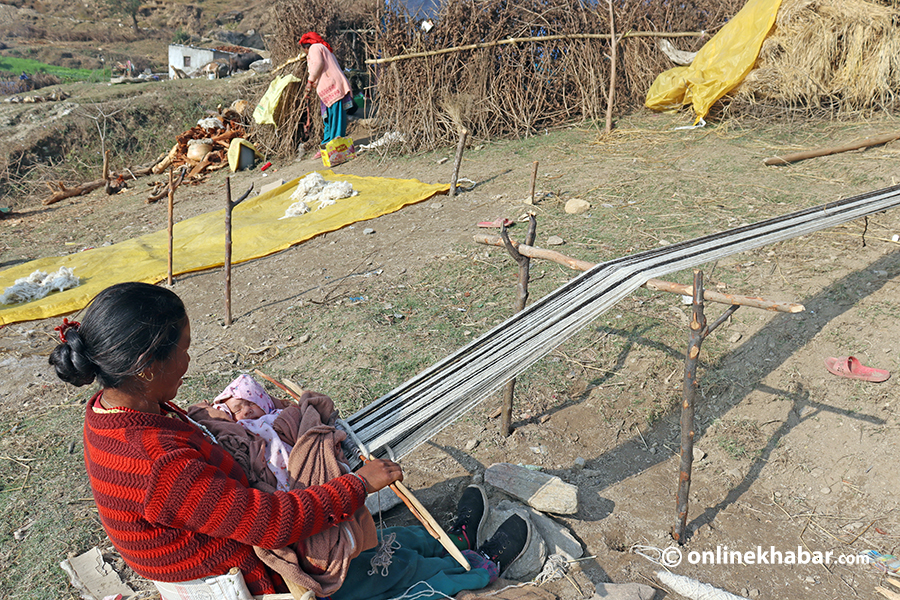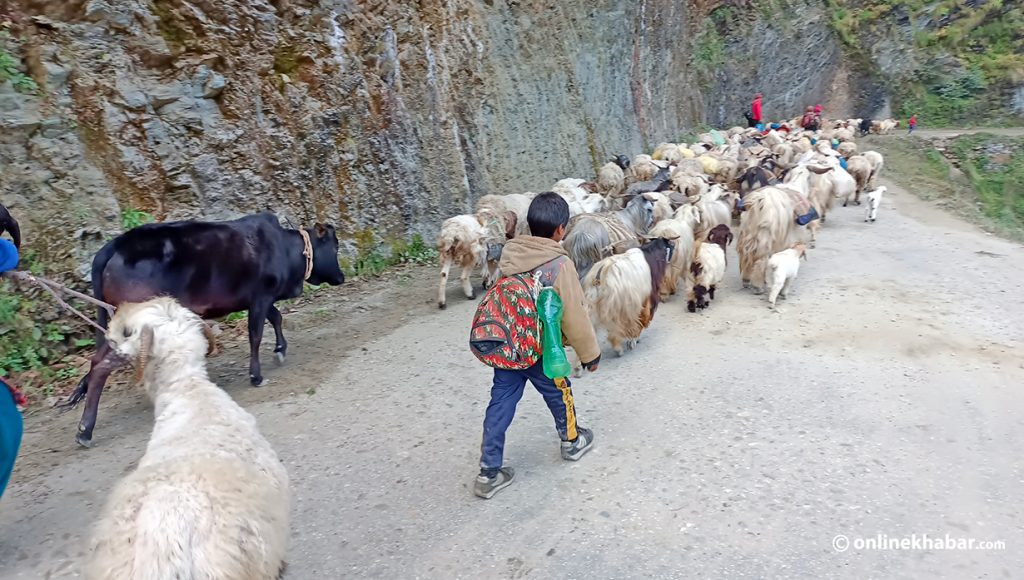
Khando Budthapa’s 2.5-year-old daughter Samjhana is malnourished; she does not look or weigh as much as a 2.5-year-old should.
The locals from Budhinanda municipality in the Bajura district of Sudurpaschim say she was malnourished from her birth. When she was two months, she had to be taken to Kathmandu for treatment. The family, however, did not have enough money to treat her fully. As a result, she remains malnourished to this day.
Khando herself is malnourished throughout her life, which is evidence of the perpetuated malnutrition in rural Nepal.
She is 40 years old and so far has given birth eight times. Two died as infants. “They died because I couldn’t feed them. I couldn’t produce milk to breastfeed them as I didn’t eat enough healthy food when I was pregnant with them,” she says. “We eat rice and salt, which wasn’t available at the time. I’ve slept on an empty stomach many times.”
None of her children was born in a health post. Some were born on a haystack while some were born on the road because if they do not relocate from the village, they will not be able to make ends meet.
“A lot of children and mothers have been victims of malnutrition around this area,” says Om Jung Shahi, health section chief of Budhinanda municipality, adding seasonal migration has been a major factor behind the trend.
Migration by mothers affects their children’s health
Mana Thapa, 39, gave birth to a son on February 6 in Achham’s Budakot. Her family relocated to Achham in November 2022. The mother and baby are fine, but as they are climate refugees, they have to live in a temporary shelter, which poses a risk to both the mother and the child.
Sita Gurung, 22, from Himali rural municipality also gave birth as she was relocating. She was moving to escape the harsh winters and gave birth in Achham’s Lekkot forest.
“I only had my husband by my side. I had to live in a wet shelter after giving birth,” says Gurung.
Months prior to childbirth are deemed important. During this time, doctors often ask mothers to eat well, not be involved in strenuous activities and keep warm. Mothers are also recommended to visit doctors regularly and take supplements of iron and vitamin A. But this is not the case in many cases around far-western Nepal where mothers are busy migrating in the winter, thereby perpetuating malnutrition in rural Nepal.
“If these facilities are not available, both the mother and child will be malnourished. There will also be immediate and long-term health effects,” says senior public health officer Ramesh Kunwar.
But there are tons of examples where women are deprived of antenatal care.
Pasang Lhamu Karki gave birth a month ago. Her daughter was born during her migration to Sanphebagar in Achham. Her daughter is malnourished along with her two other children whom she gave birth to on her way back to the mountains.
She is not vaccinated, nor has she undergone any checkups. She has not even been able to give her newborn the BCG vaccine.
“We have to relocate depending on the weather. We rarely have time to go get our children vaccinated. Pasang is okay, but the kids are malnourished,” says Prem Kami Bhote, Pasang’s husband.
When we met Pasang, she was eating dry chapati with salt. She had given birth 20 days ago yet there she was, weaving a woollen rug, which she would sell for food.
Indigenous communities and the illiterate’s woes

The statistics of the Nutritional Rehabilitation Centre, which has just been opened at the Bajura District Hospital, also show that children of indigenous communities who migrate seasonally are suffering from malnutrition. Auxiliary health worker Parbati Jaisi says that only 17 children are being treated in the rehabilitation centre and most of them are from the indigenous community.
Seasonal migration of Bhote tribes has contributed to a lot of malnutrition in rural Nepal. Some communities from Bajura, Bajhang, Mugu, Humla, and Jumla districts migrate seasonally. They mostly migrate to Achham in winter and the Himalayan region in summer. However, there is no official data on how many of these migrants are malnourished, says Tek Bahadur Khadka, the health coordinator of Badimalika municipality.
Many children are born unsafe, on the road, so their health is very poor. The mothers are at risk too as they do not have access to nutritious food and have to continue to work hard to make ends meet both pre and post-pregnancy.
“As we are poor, we have no option but to migrate between mountains and foothills. So many women give birth during migration,” says Agmati Thapa Bhote.
As they do not have access to health services or timely vaccination, many die due to malnutrition. Many do not know they have to get vaccinated either. Hence, death during childbirth, in many communities in far-west Nepal, has been normalised.
Even though there are health posts around these districts, the terrain makes it hard for people to access them at times of need. In addition, health institutions in remote areas are less effective in terms of services and resources.
“When you can’t access a health post on time, malnutrition takes an ugly turn,” says Deepak Shah, health coordinator of Budhiganga municipality.
Alarming data

A malnutrition survey recently conducted by the Sudurpaschim Province Health Directorate shows that the rate of malnutrition in Bajura is high.
Out of 69 wards of nine local units of Bajura, 27 wards were surveyed. The study found stunting was observed in 48.8 per cent of the children aged 5 or less, obesity in 8.6 per cent and underweight in 30.6 per cent.
Mahesh Chand, the head of the Bajura Health Office, says that this rate shows that the rate of malnutrition in rural Nepal, Bajura being an exemplary case, is very high. Statistics show that the rate of malnutrition among indigenous children is high.
Although the mortality of mothers and children of the Bhote tribe is high, this information is not available in the health institutions of the district. It is not easy to know the exact record as they do not visit health posts.
“These settlements are located in remote villages. Since they migrate every year, it is a problem to keep statistics,” says Chand.
In addition, many mothers of the Bhote tribe have uterine problems. This problem is seen due to unsafe childbirth and having many children.
Take Hiukala Gurung of Himali rural municipality, for example, who has given birth to eight children.
Since the birth of her fifth child, she has been suffering from uterine prolapse. She gave birth to all the children at home or in a forest. Due to her poor financial situation, she has not been able to get treatment yet.
Anaemia is another problem that many women from the community are facing. Manukala Thapa, 44, who lives in Himali rural municipality, has anaemia. She gave birth to nine children. She says that even though she has problems related to her uterus, she has not been to a health post to get it checked.
The problem of uterine prolapse is directly related to malnutrition in rural Nepal. According to Senior Public Health Officer Ramesh Kunwar, a study conducted in Nepal has shown that malnutrition, heavy work during pregnancy and lack of adequate rest after delivery, lack of proper time between one baby and another, and prolonged pain during delivery increase the problem of uterine prolapse.
Mothers continue to die

Over the past four years, 10 maternal deaths have been reported in the Bajura district, which stakeholders say is directly related to the status of malnutrition in rural Nepal. Most of these women died as they did not get timely treatment. Five people died in 2019, one in 2020 and two each in 2021 and 2022.
Out of the 10 who died, seven died at a health facility, one died at home and two died on the way to a health facility in Dhangadi.
According to Khadka, the health coordinator of Badimalika municipality, this is the result of a lack of regular pregnancy check-ups post-pregnancy and not providing health facilities to deliver on time.
Although the government has launched an air rescue programme, the death of pregnant women and new mothers has not stopped as women are not aware of the dos and don’ts during and after pregnancy.
The average life expectancy of Nepalis is 69 years. However, the life expectancy of the residents of Bajura is only 59 years. The condition of mothers in Bajura is even more painful as 14 per cent of the population does not live beyond the age of 40, due to poverty.
“When pregnant, the baby in the womb needs nutrients through the blood. In such a situation, iron and folic acid deficiency in the mother cause anaemia. Anaemia is also a complex condition of malnutrition,” says Kunwar.
This story was translated from the original Nepali version and edited for clarity and length.




















